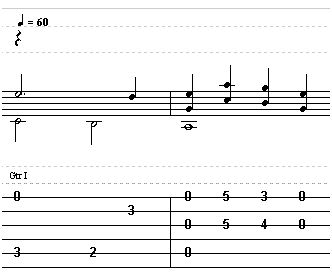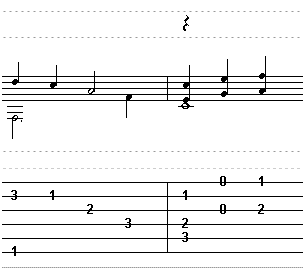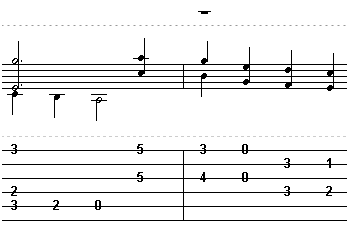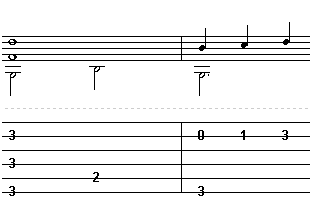In this tutorial we’ll explore low melody and high melody by studying a rendition of the song “Danny Boy” in which we’ve applied fingerstyle. The song snippet itself isn’t hard to play or even finger, but you’ll see that there are a quite a few note-related points of interest. This is VERY common in fingerstyle guitar. You really have to understand note values and how they relate, so I decided to add that right here before everything gets too complex. Before we begin this second introduction to fingerstyle guitar, we have to learn something very important.
Low Melody and High Melody
Notice on the tablature below that you’ll see the note values both in upright position, and some that are ‘upside down.’ In fingerstyle guitar, this tells us that there are low and high melodies. While the low and the high melody might not play at different values, sometimes they do. Right now, I haven’t included anything too advanced, so you can treat both low and high melodies roughly the same way. I just wanted to point out that if you see a note value turned ‘upside down,’ that simply means it is a low melody.
This tablature represents a series of fingerstyle picking that incorporates the usage of your thumb, 1st, and 2nd finger.
Notation Legend:
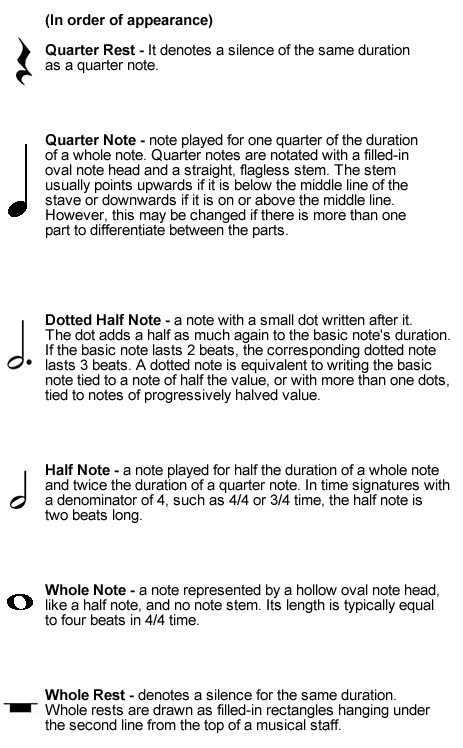
Measures 1 – 2
Breakdown (Measure 1):
- We begin with the high melody (open high E string) playing a dotted half-note WHILE the low melody (‘3’ on the A string) plays a standard half note.
- We then play the high melody (the ‘3’ on the B string) using a quarter note,
- AFTER the low melody (‘2’ on the A string) plays a half note.
Breakdown (Measure 2):
- All notes in Measure 2, except for the open note on the A string (which IS a low melody note, but the whole note symbol doesn’t change) are played with quarter notes. Simple huh?!
Measures 3 – 4
Breakdown (Measure 3):
- This is basically an F chord. Check it out on the tablature. The low melody note (the ‘1’ on the Low E string) is played with a dotted half note WHILE the high melody note (the ‘3’ on the B string) is played using a standard quarter note.
- Next, the ‘1’ on the B string is played using a quarter note, and then we play the ‘2’ on the G string using a half note. End this measure with a low melody note of ‘3’ on the D string playing a quarter note.
Breakdown (Measure 4):
- A simple quarter note progression with an added low melody note of ‘3’ on the A string.
Measures 5 – 6
Breakdown (Measure 5):
- Here we have two high melody notes playing dotted half notes. While this is played, the low melody note, the ‘3’ on the A string, plays a quarter note.
- The low melody note of ‘2’ is played with a quarter note, and then the open string note on A is played with a half note. End the measure with ‘5’ on the G string and ‘5’ on the high E string playing quarter notes.
Breakdown (Measure 6):
- Much like Measure 2, this entire measure plays using quarter notes.
Measures 7 – 8
Breakdown (Measure 7):
- Both low melody notes (the ‘3’ on the Low E string and the ‘2’ on the A string) play using half notes, while the high melody note (the ‘3’ on the B string) plays using a whole note, as well as the ‘3’ on the D string.
Breakdown (Measure 8):
- This could be considered the turnaround to the song, since we aren’t playing it in its entirety. This is pretty easy.
- We play the ‘high’ melody using a quarter note on the open B string (all high melody parts in the eighth measure are quarter notes).
- The ‘low’ melody, which is the ‘3’ on the Low E string plays using a dotted half-note.
